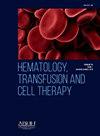SERUM METABOLOMIC ANALYSES IN RECTAL CANCER PATIENTS: AN EXPLORATORY STUDY FROM A TIME-COURSE PERSPECTIVE
IF 1.8
Q3 HEMATOLOGY
引用次数: 0
Abstract
Introduction/Justification
Patients with colorectal cancer frequently develop cachexia, leading to severe depletion of skeletal muscle. Metabolomics, through the analysis of metabolite profiles using nuclear magnetic resonance (NMR), shows promise in identifying biomarkers for diagnosis and treatment, providing crucial insights into tumours and metabolic changes, allowing for an enhanced understanding of the mechanisms related to the cancer-cachexia process.
Objectives
In the present study, we analysed the most impacted metabolic pathways affected after a glycaemic clamp in the serum of patients with rectal cancer diagnosed with sarcopenia (S) or not (NS).
Materials and Methods
In this preliminary study, serum samples collected from rectal cancer patients were prepared through filtration to remove proteins and lipids, followed by the addition of deuterium buffer for magnetic field calibration. The spectra were obtained using NMR (500 MHz), allowing precise identification and quantification of metabolites in biological samples. The obtained spectra were processed by CHENOMX software for phase adjustment, baseline correction, and spectral alignment, and then analysed for metabolic pathways using MetaboAnalyst software. Finally, metabolic profiles were correlated with clinical data from patients ((S) or (NS)) and the time course of the glycaemic clamp (initial time (T0) and final time (after 120 minutes, T1)). Institutional Review Board approval (CAAE: 91217418.2.0000.5404).
Results
A total of 7 patients were analysed, 3 S and 4 NS. All S were female, and NS group had 3 males and 1 female. The median age was 64 (43-66) years for S and 69 (58-74) years for the NS group. The M-value-TBW and M-value-FFM median (P25-P75) were 4,2 (3,40-5,55) and 4,4 (3,75-5,25), for the S group, and 7,20 (5,65-8,95) and 6,10 (5,63-6,63) for the NS group, respectively. Sarcopenic patients – S –, compared to NS patients, at T0, exhibited increased levels of glycerol (indicating mobilisation of body fat), glycine and threonine (suggesting lean body mass depletion), as well as methylhistidine (corresponding to skeletal muscle degradation), with maintained levels of alanine and urea. After 120 minutes (T1), S patients showed an increase in serum alanine, glycine, and urea, still with a high serum concentration of glycerol, though similar to NS patients, and a reduction in threonine and methylhistidine levels compared to NS patients. These metabolite alterations directly impacted metabolic pathway vias related to lipoic acid metabolism, glutathione metabolism, tryptophan metabolism, branched-chain amino acid degradation (leucine, isoleucine, and valine), glycolytic and gluconeogenic pathways, and pyruvate and pyrimidine metabolism in S patients compared to NS patients.
Conclusion
The study reveals that S patients present a distinct metabolic profile, impacting metabolic pathways, mainly related to cachexia syndrome effects, compared to NS individuals, thereby enhancing our understanding of the metabolic disturbances in this condition. Mendes, MCS and Madeira, BSM are sharing the first authorship. Gomes-Marcondes, MCC and Carvalheira, JBC were co-advisors in these studies.
直肠癌患者血清代谢组学分析:一项从时间过程角度的探索性研究
结直肠癌患者经常出现恶病质,导致骨骼肌严重衰竭。代谢组学,通过使用核磁共振(NMR)对代谢物谱进行分析,在识别诊断和治疗的生物标志物方面显示出希望,为肿瘤和代谢变化提供重要的见解,从而增强对癌症-恶病质过程相关机制的理解。目的在本研究中,我们分析了诊断为肌肉减少症(S)或非肌肉减少症(NS)的直肠癌患者的血清中血糖钳夹后受影响最大的代谢途径。材料与方法在本初步研究中,收集直肠癌患者的血清样本,通过过滤去除蛋白质和脂质,然后加入氘缓冲液进行磁场校准。利用核磁共振(500 MHz)获得光谱,可以精确鉴定和定量生物样品中的代谢物。获得的光谱通过CHENOMX软件进行相位调整、基线校正和光谱校准,然后使用MetaboAnalyst软件分析代谢途径。最后,代谢谱与患者(S)或(NS)的临床数据以及血糖钳夹的时间过程(初始时间(T0)和最终时间(120分钟后,T1)相关。机构审查委员会批准(CAAE: 91217418.2.0000.5404)。结果共分析7例患者,其中3例为S型,4例为NS型。S均为女性,NS组男性3例,女性1例。S组的中位年龄为64(43-66)岁,NS组的中位年龄为69(58-74)岁。S组M-value-TBW和M-value-FFM中位数(P25-P75)分别为4,2(3,40-5,55)和4,4 (3,75-5,25),NS组分别为7,20(5,65-8,95)和6,10(5,63-6,63)。肌少症患者- S -与NS患者相比,在T0时,表现出甘油(表明体脂肪的动员),甘氨酸和苏氨酸(表明瘦体重消耗)以及甲基组氨酸(对应于骨骼肌降解)水平的增加,丙氨酸和尿素水平保持不变。120分钟(T1)后,S患者血清丙氨酸、甘氨酸和尿素升高,血清甘油浓度仍较高,但与NS患者相似,苏氨酸和甲基组氨酸水平较NS患者降低。与NS患者相比,这些代谢物的改变直接影响了S患者与硫辛酸代谢、谷胱甘肽代谢、色氨酸代谢、支链氨基酸降解(亮氨酸、异亮氨酸和缬氨酸)、糖酵解和糖异生途径以及丙酮酸和嘧啶代谢相关的代谢途径。结论研究表明,与NS个体相比,S患者具有不同的代谢特征,影响代谢途径,主要与恶病质综合征效应有关,从而增强了我们对该疾病代谢紊乱的认识。Mendes, MCS和Madeira, BSM共享第一作者。MCC的Gomes-Marcondes和JBC的Carvalheira是这些研究的共同顾问。
本文章由计算机程序翻译,如有差异,请以英文原文为准。
求助全文
约1分钟内获得全文
求助全文
来源期刊

Hematology, Transfusion and Cell Therapy
Multiple-
CiteScore
2.40
自引率
4.80%
发文量
1419
审稿时长
30 weeks
 求助内容:
求助内容: 应助结果提醒方式:
应助结果提醒方式:


